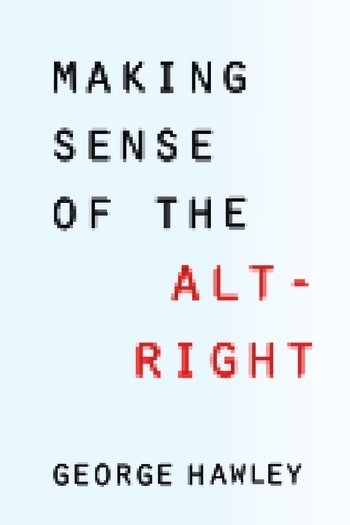The Long History of White Nationalism in America
“The issue of tone is important. Rage and hate were the primary emotions associated with the older white-nationalist movement. Even when it dabbled in popular culture, such as with the record label Resistance Records (which released punk and heavy-metal albums with white-nationalist lyrics), it was a movement transparently driven by resentment…. The Alt-Right offers something more attractive to potential supporters: edginess and fun.” — George Hawley
This week, our featured book is Making Sense of the Alt-Right, by George Hawley. To start the feature, we are happy to present an excerpt, originally featured at LitHub, in which Hawley discusses the legacy of white nationalism in the United States, and the difficulty in tracing the lineage of the Alt-Right. You can read the article in full at LitHub.
Don’t forget to enter our book giveaway for a chance to win a free copy!
The Long History of White Nationalism in America
By George Hawley
Detailing the history of white nationalism in America is trickier than it first appears. This is because, despite the egalitarian rhetoric of the Declaration of Independence, the United States operated as a de facto white-supremacist nation for most of its history. This has been a subject of controversy for decades. No one disputes that slavery poses a problem for the narrative that America is, and always was, a beacon for freedom and equality. But debates continue as to what the most important Founding Fathers “really” thought about race and the future of equality.
…
Moving forward through history, it is easy to find evidence that Americans continued to view the United States as a “white country,” and policies designed to maintain white demographic dominance were often uncontroversial: the Chinese Exclusionary Act of 1882, the Immigration Act of 1924 (which ushered in a four-decade period of low immigration), and President Eisenhower’s Operation Wetback (which forcibly deported undocumented immigrants), to name just a few. The Progressive movement that thrived in the early 20th century had a transparent racial and eugenicist element to it. Famous progressive eugenicists such as Madison Grant and Lothrop Stoddard thought the idea of racial equality was absurd. The United States began to change course on issues of race following World War II, eventually abolishing racial segregation, allowing large-scale immigration from non-European countries, and later electing an African American president. But white supremacy was formally institutionalized throughout most of American history.
On this point, many of today’s white nationalists and contemporary progressives agree. Conservatives frequently argue that America’s founders had a sincere vision of equality and that they pointed the way toward a peaceful, diverse, and egalitarian society. But this narrative is commonly rejected today by both white nationalists and progressives. Jared Taylor, of the “race-realist” group American Renaissance, probably agrees with Senator Bernie Sanders on very little, but his own writings on this subject (“Since early colonial times, and until just a few decades ago, virtually all Whites believed race was a fundamental aspect of individual and group identity”) clearly echo Sanders’s claim that the United States was created “on racist principles.” Although they reach different conclusions, both men argue that the United States was viewed by its founders as a country for people of European ancestry.
For all of these reasons, it is important to disaggregate those groups and individuals throughout American history that were white nationalist and white supremacist in a general sense—that is, they accepted the views on race that were common at the time—from those that treated race as their primary concern. When thinking about the history of white racial movements in the United States, the first group that typically comes to mind is the Ku Klux Klan, which formed in the South during the Reconstruction era, though it faded from prominence after just a few years. The Klan experienced new growth, in both the North and South, following the release of the 1915 film The Birth of a Nation, which valorized the group.
…
The issue of tone is important. Rage and hate were the primary emotions associated with the older white-nationalist movement. Even when it dabbled in popular culture, such as with the record label Resistance Records (which released punk and heavy-metal albums with white-nationalist lyrics), it was a movement transparently driven by resentment. No one could read The Turner Diaries without being convinced that William Pierce literally wanted to see nonwhites exterminated. The Alt-Right offers something more attractive to potential supporters: edginess and fun. Someone who would never associate with a group like the Klan or the National Socialist Movement might eagerly watch YouTube videos by the Alt-Right satirist RamZPaul. This is a curious paradox of the Alt-Right; it may ultimately be a greater threat to mainstream politics than these earlier groups precisely because it often comes across as much less threatening.






